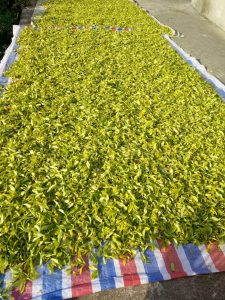In this video, Zhuping is visiting Mr. Liu’s rock wulong tea factory where he walks us through the process of how rock wulong is made. We left the conversation between Mr. Liu and Zhuping intact for our customers who prefer to listen to the interview in its entirety. Unfortunately, part of it was hard to understand with the audio in the background! If you need to refer to any portion of it, we’ve written it below for you to follow.
The Overall Process for Making Wu Yi Shan Rock Wulong Tea
First, the tea is withered under sunshine for about 8-15 hours.

After the tea leaves are carried to the factory, they are placed on bamboo trays where they are prepared to undergo yao qing, or “shaking the leaves”. In some factories, this is done through a long tube where air is blown through the leaves. If the process is performed when there is a lot of moisture in the air, they will add heat to one end of the tube through which the air gets blown.
What follows next is what’s known as sha qing-“kill the green” phase. The tea will be put through a hot rolling machine to kill the enzymes and prevent any additional oxidation process from occurring. This typically lasts for about 8-10 minutes or so. The exact amount of time will depend on the tea that’s being produced and how the tea leaves ought to look at the final product.
The next machine that is seen pushes the tea leaves down and it goes through a rolling and kneading process. This is the step that produces its shape. After this is completed, it is ready to be sent into a machine for roasting. The product for this stage is what is known as mao cha. You can think of mao cha as being unfinished, unprocessed tea. Mao cha, in the context of wulong, is tea that has not yet undergone the separation of sprigs and unfolded leaves from the tea that will be used to ultimately make the wulong. The term that is used in the video is huang pian, which translates to “yellow leaves”. These undesirables must be sorted from the tea before it begins the process of roasting that defines wulong tea.
From there, a machine is used to roast the mao cha about 2-3 times every ten minutes or so. The skilled labor involved in roasting the tea and frying it by hand adds immensely to the cost of the tea. In fact, this is used for only small quantities of high quality specialty tea. The tea is further dried by a roasting that occurs by charcoal and this often takes about 5 to 6 hours. For some teas, this can take even 10 hours. The difference between the length of times of roasting is distinguished by differentiating between lightly roasted wulong and strongly roasted wulong. Strongly roasted wulong is roasted for about 10 hours or more. The roast can include other materials but they must be “concentrated”. Pine, as Mr. Liu points out, would not be ideal for this part of the process.
